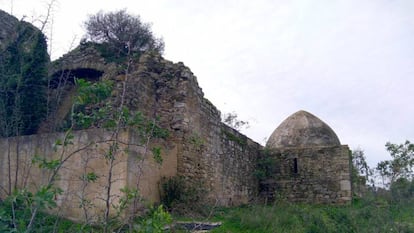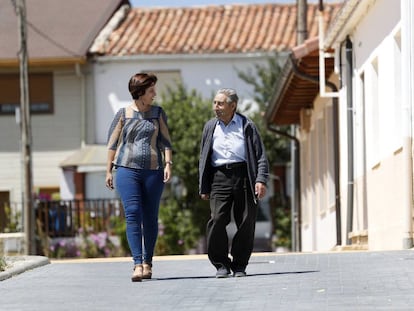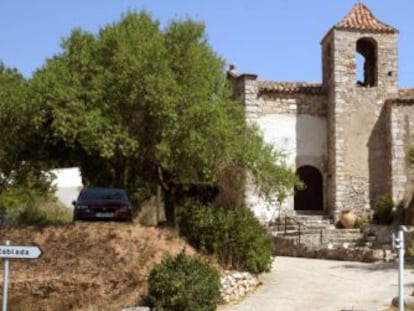What can be done to save Spain’s historic buildings from ruin?
Architectural heritage endangered by spending cuts, with rural depopulation a key factor
Dozens of ancient monuments throughout Spain supposedly protected by the state are being looted and falling into ruin. The blame lies partly with deep spending cuts in recent years, made worse by the closure of many savings banks, which dedicated substantial resources to caring for listed buildings. At the same time, rural depopulation has made it easier for thieves and vandals to damage historic sites.

Spain ranks third in terms of its number of UNESCO World Heritage sites (45), beaten only by China and Italy. José María Pérez, president of the Fundación Santa María la Real del Patrimonio Hístorico, a privately run heritage organization, says the most vulnerable area is along the sparsely populated Spanish-Portuguese border, taking in the provinces of Ourense, Lugo, León, Zamora, Salamanca and Cáceres, along with provinces further inland such as Palencia, Soria, Teruel, Guadalajara and Cuenca.
“This is a Spain that is emptying, villages with few people, churches closed down and monasteries with virtually nobody in them. This is unstoppable, it’s like a slow-motion earthquake,” says Pérez, adding that without local populations to sustain them, restored buildings will simply fall into disrepair over time.
Many monuments are not properly signposted or accessible and so are never visited
“It would take at least 20 years to repopulate these areas,” he says, arguing that a repeat of the policies of the Middle Ages is required today: “The monarchy granted certain rural privileges. We need something similar, providing good services and high-speed internet, reducing taxes in rural areas, positive discrimination policies for women and tax breaks for restoring historic buildings… We have to facilitate resettlement, but not based solely on agriculture. A lot of people could live from renovating those buildings.”
Araceli Pereda is the president of Hispania Nostra, a not-for-profit body set up in 1976 to help protect Spain’s cultural heritage, and which has drawn up a list of 700 buildings it says are in danger. She agrees that reviving the Spanish countryside is essential: “Revitalizing these areas would see people return to their villages, even if only sporadically. This would be a source of revenue through restaurants, shops, hotels... It’s not just about protecting buildings of historical and artistic value, but the environment around them, the countryside.”
For the moment, restoration is not on the cards: spending by Spain’s savings banks, many of which were hit hard by the collapse of the property market in 2008, provided some €109 million that year toward protecting Spain’s architectural heritage; by 2012, that figure fell to €11.2 million. State spending on Spain’s historical buildings “fell by 44% between 2008 and 2014, from €464 million to €261 million,” says José Manuel García Diego of Protecturi, a heritage foundation that has prepared a report on the impact of the crisis on Spain’s cultural heritage. Between 2015 and 2016, spending fell by a further 5%, he says.
Responsibility for Spain’s architectural heritage has been largely devolved to regional governments, says García Diego. He says overall, spending in this area fell by more than half from €590 million to €259 million. At the local level, spending fell by 61%, from €657.2 million to €254.6 million. “Adding up the budgets of all levels of government, spending on our historic heritage has gone from €912.5 million in 2007 to €199.6 in 2013: we are moving toward chronic austerity,” he warns.
Without populations to sustain them, restored buildings will simply fall into disrepair over time
Pérez also highlights the need for the Roman Catholic Church to look after the many historic properties it owns. “It needs to understand that churches do not just have a religious function, but also a cultural one, particularly when they are empty.”
What is needed, says Pérez, is a “national plan” to digitally catalogue every historic building in Spain and to then establish repair and maintenance priorities. He also points out that many architectural and cultural treasures in rural areas are not properly signposted or accessible and so are never visited.
The Spanish government sees a role for the private sector in helping safeguard the country’s historic buildings. Fernando Benzo, Secretary of State for Culture, highlights the “fundamental role” played by business and intends to present Congress with a draft law to allow private patronage.
Protecturi supports the move, but Pérez disagrees, arguing: “What belongs to everybody should be paid for by everybody.”
English version by Nick Lyne.
Tu suscripción se está usando en otro dispositivo
¿Quieres añadir otro usuario a tu suscripción?
Si continúas leyendo en este dispositivo, no se podrá leer en el otro.
FlechaTu suscripción se está usando en otro dispositivo y solo puedes acceder a EL PAÍS desde un dispositivo a la vez.
Si quieres compartir tu cuenta, cambia tu suscripción a la modalidad Premium, así podrás añadir otro usuario. Cada uno accederá con su propia cuenta de email, lo que os permitirá personalizar vuestra experiencia en EL PAÍS.
¿Tienes una suscripción de empresa? Accede aquí para contratar más cuentas.
En el caso de no saber quién está usando tu cuenta, te recomendamos cambiar tu contraseña aquí.
Si decides continuar compartiendo tu cuenta, este mensaje se mostrará en tu dispositivo y en el de la otra persona que está usando tu cuenta de forma indefinida, afectando a tu experiencia de lectura. Puedes consultar aquí los términos y condiciones de la suscripción digital.
More information
Últimas noticias
The complicated life of Francesca Albanese: A rising figure in Italy but barred from every bank by Trump’s sanctions
Half of Scotland is in the hands of 420 property owners
Reinhard Genzel, Nobel laureate in physics: ‘One-minute videos will never give you the truth’
Pinochet’s victims grapple with José Antonio Kast’s rise in Chile
Most viewed
- Pablo Escobar’s hippos: A serious environmental problem, 40 years on
- Why we lost the habit of sleeping in two segments and how that changed our sense of time
- Charles Dubouloz, mountaineering star, retires at 36 with a farewell tour inspired by Walter Bonatti
- Trump’s obsession with putting his name on everything is unprecedented in the United States
- The Florida Keys tourist paradise is besieged by immigration agents: ‘We’ve never seen anything like this’











































